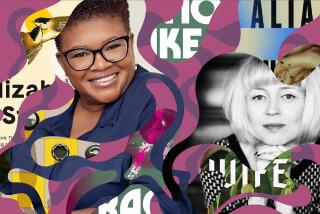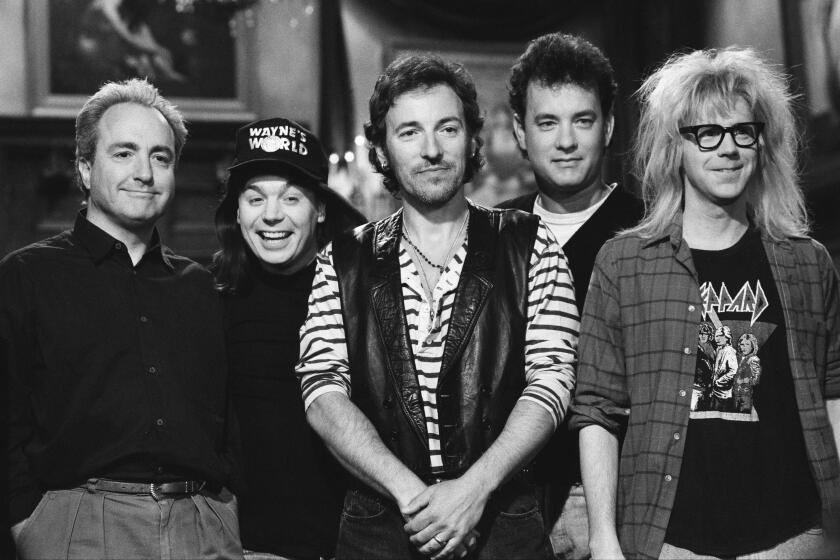The scents and sensibility of a high-society publisher
- Share via
NEW YORK — Publisher Prosper Assouline is sniffing a $250 book. He has hoisted the enormous tome “Masks” by Thierry Despont from the table in front of him, swung it open and inserted his nose. He looks a bit like a bookworm with an extreme case of myopia. But he is not reading. Although Assouline is a man who sells books, he is not one who traffics in words. He sells style. And he believes wholeheartedly that one can -- and should -- judge a book by its cover.
Assouline made his professional reputation as an art director and continues to create glamorous marketing campaigns for companies such as Harry Winston. But he also has turned his attention to the publishing world, where he sells fashion books that are rich, grand and suitable for photographing atop a Christian Liagre coffee table. When Assouline walks into Barnes & Noble, he practically weeps. So many unattractive books.
His company sells a lot of things -- fancy composition books for $125, $149 decorative ostrich eggs hand-painted with a letter from the alphabet, $750 cashmere throws, $1,200 bronze bookends made from vintage Masai leg bracelets and $45 candles. The candles come in three scents: wood, leather and bibliotheque. Bibliotheque, which is French for library, is meant to smell like a book.
“The Diptyque people make the candles,” says Assouline, who is French. “The woman tell me I am crazy. She say, ‘Give me three books you love to smell.’ ”
So he went home and searched his stacks for a pleasing bouquet.
In order to placate a skeptic who finds it difficult to believe that books have distinctive odors -- other than the stench of overwrought prose -- he has offered “Masks” as evidence.
“Masks” is a handmade picture book of cotton paper. It weighs as much as an infant. And it has a distinct scent that is woodsy and dusty, with a hint of ink. Maybe it smells good. Maybe it just smells.
For comparison, he offers “Ricky Lauren: Cuisine, Lifestyle, and Legend of the Double RL Ranch,” which sells for $50. The book stinks like wet paint.
The scent lacks character, he says. “We print it in China.” But Assouline is a businessman as well as an aesthete, and so he notes, “The book sold out, so it smells good.” Then he laughs.
Assouline has become the fashion industry’s favorite publisher for books that are beautiful, splashy and highly flattering. He does not deal in unauthorized biographies about designers and their demons. In the world of Assouline, designers do not wrestle with addictions. They are not on the edge of bankruptcy. They lead glamorous lives in exquisite houses and make spectacular clothes.
“I think vanity is a perfectly good reason to publish a book,” Assouline says. “I appreciate when people think a book is beautiful or for decoration because I know when you open the book it’s going to be a good book.”
When the Council of Fashion Designers of America decided last year to create a pictorial history of American style, it turned to Assouline. In 2004 he published a book about designer Carolina Herrera. It is, of course, a picture book, but it isn’t filled with photographs from the designer’s runway shows or of the famous women who have worn her clothes -- Renee Zellweger, Laura Bush. It is page after page of Herrera herself.
“When we make a book on a designer, it’s important to get the spirit of each designer,” Assouline says. “What’s most important about Carolina is her. So we make a book not about clothes but her, on 200 pages. After that we make a book on Donna Karan, but it’s different because she comes from marketing. So it’s all about her ads. With Oscar [de la Renta], the most important with Oscar is the life. To eat well, to travel. The book is like a personal album.”
And who is the audience? Who, for instance, is interested in a $60 book of photographs of Herrera, a designer with whom the average person is unfamiliar? “The first client for ‘Carolina’ is Carolina,” Assouline says, meaning that Herrera’s company agreed in advance to purchase a significant number of the 7,000 books produced. (“I can’t comment on business relationships with outside companies,” says Herrera publicist Phoebe Gubelman.)
“I wouldn’t call it vanity publishing, but it gives you a sense of the kind of deals that can be made,” says Barbara Hoffert, editor of the book review at Library Journal, a publishing trade paper. “There’s a lot of people with a lot of money and an interest in celebrities.... There’s enough people to make a go.”
Assouline owns Assouline Publishing with his wife, Martine. The company office is a large loft with expansive views of the Hudson River. There are no free-standing Assouline stores in the United States, but the company has opened mini-boutiques inside Bergdorf Goodman and certain Saks Fifth Avenue stores, and the books are available through Amazon.com. The only free-standing store is in Paris, where the company is based. The wares at Assouline, where the books are neither thumbed nor seemingly even opened, have more in common with fancy handbags than existentialism.
“I’m building a luxury brand,” the publisher says, “and the medium is culture.”
Assouline focuses on fashion and other subjects that lend themselves to striking pictures and the absence of words. He does not have an aversion to literature. (The last book he read, he says, was Gabriel Garcia Marquez’s “One Hundred Years of Solitude.”) But his plan since starting the company 11 years ago was to build a global luxury brand whose products can seamlessly cross borders. Having to translate pages of words into French, Italian and other languages only complicates matters. So far, the company has published about 700 titles.
“I try to write something with images,” he says. He pulls out a book about the fashion designer Coco Chanel and the company she founded. It is a wisp of a volume. The entire history of the quilted Chanel handbag is distilled into a single page -- a chalk outline of a black purse.
Other companies -- Rizzoli, Abrams, Thames & Hudson -- publish big, glossy coffee-table books. But Assouline is not so much selling individual books as selling a cohesive aesthetic statement. “Presentation is very important for me,” he says. “Each book has to have a link with another one. I have 50 different books, but in the end it’s the same book. All of the 50 books are linked together. The subject is different, but the layout gives the sensibility that it’s the same book.”
The books, like so many Kelly bags or pieces of “LV”-adorned luggage, represent the brand, Assouline says.
“I think of it as a fairly specialized house,” says Hoffert of Library Journal. “Art publishing has been going through a lot of changes since I came here 20 years ago. The trends have moved away from the Picasso and Renoir books and more towards illustrated books -- views of seashells and beach houses.”
“I think of them as objets d’art as opposed to books,” Hoffert says.
Assouline, 49, a slender man who favors black suits and wears his dark hair combed away from the face, first gained prominence in the United States as the publisher of voyeuristic picture books about New York’s young socialites. “Bright Young Things,” by Brooke de Ocampo, was published in 2000 and offered a peek inside the well-decorated homes of her famously wealthy friends with last names such as Lauder, Von Furstenberg and Lauren. The success of that book, which he estimates has sold 80,000 copies, spawned “Happy Times” by Lee Radziwill, the sister of Jacqueline Onassis, in 2001, a photo reminiscence of her life in the 1960s.
Assouline is reticent to discuss his company’s history as a socialite’s publisher. Some writers called him pretentious because of it, an accusation that bruised his feelings. (Even now he has a tendency to fret about being characterized that way: “Do you think I’m pretentious?” he asks more than once.) The society books, he says, represent only a small piece of his vision for the company. They are what he describes as social anthropology: a picturesque slice of a curious, rare kind of life.
“I have no shame on that, society books. I can tell you the truth, it gave us an image when we just arrived,” he says.
The Memoire Collection, which dates back to the company’s founding, is a growing series of small, slim books on fashion designers and artists. The books have fewer than 100 pages and not a lot more words. Assouline describes them as “cookies”: tempting and tasty but with no real nutritional value. “One is nothing alone,” he says.
“Now it’s very amusing and people call to say, ‘I want 2 meters of ‘Memoires’ ” to decorate a shelf.
Do they specify the titles?
“I don’t think they care.”
Neither does Assouline.
More to Read
Sign up for our Book Club newsletter
Get the latest news, events and more from the Los Angeles Times Book Club, and help us get L.A. reading and talking.
You may occasionally receive promotional content from the Los Angeles Times.







